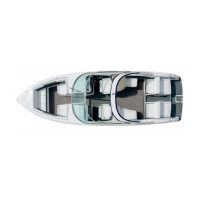Vessel Operation
5-5
During Fueling
Keep the fuel nozzle in contact with the fuel fi ll to guard against
static sparks. The fuel fi ll pipe is grounded through the fuel
system wiring to protect against static electricity.
Avoid overfi lling the fuel tank. Leave room for expansion. Also,
if fuel exits the fuel vent indicating the tank is full, this situation
is dangerous and unfriendly to the environment.
Avoid spilling any fuel. Clean up any fuel accidently spilled with
a clean rag and dispose of it onshore.
After Fueling
Close all fuel fi ll openings tightly. Use a fuel key if needed.
Open all portholes, hatches and doors.
Energize the blower for a minimum of 4 minutes.
Sniff in the lower bilge and engine compartment for gas fumes.
If fumes are detected continue to ventilate until the odor is gone.
Look for any traces of fuel droplets or spillage. Do not start the
engines, smoke or run any electrical components except
the blower until the fumes can no longer be detected.
AVOID SERIOUS INJURY OR DEATH!
THE OPERATOR OF THE CRAFT MUST HAVE
COMPLETE CONTROL OF THE HELM STEERING
STATION WHILE THE VESSEL IS MOVING.
NEVER LEAVE THE HELM STATION UNATTENDED
WHILE THE VESSEL IS MOVING.

